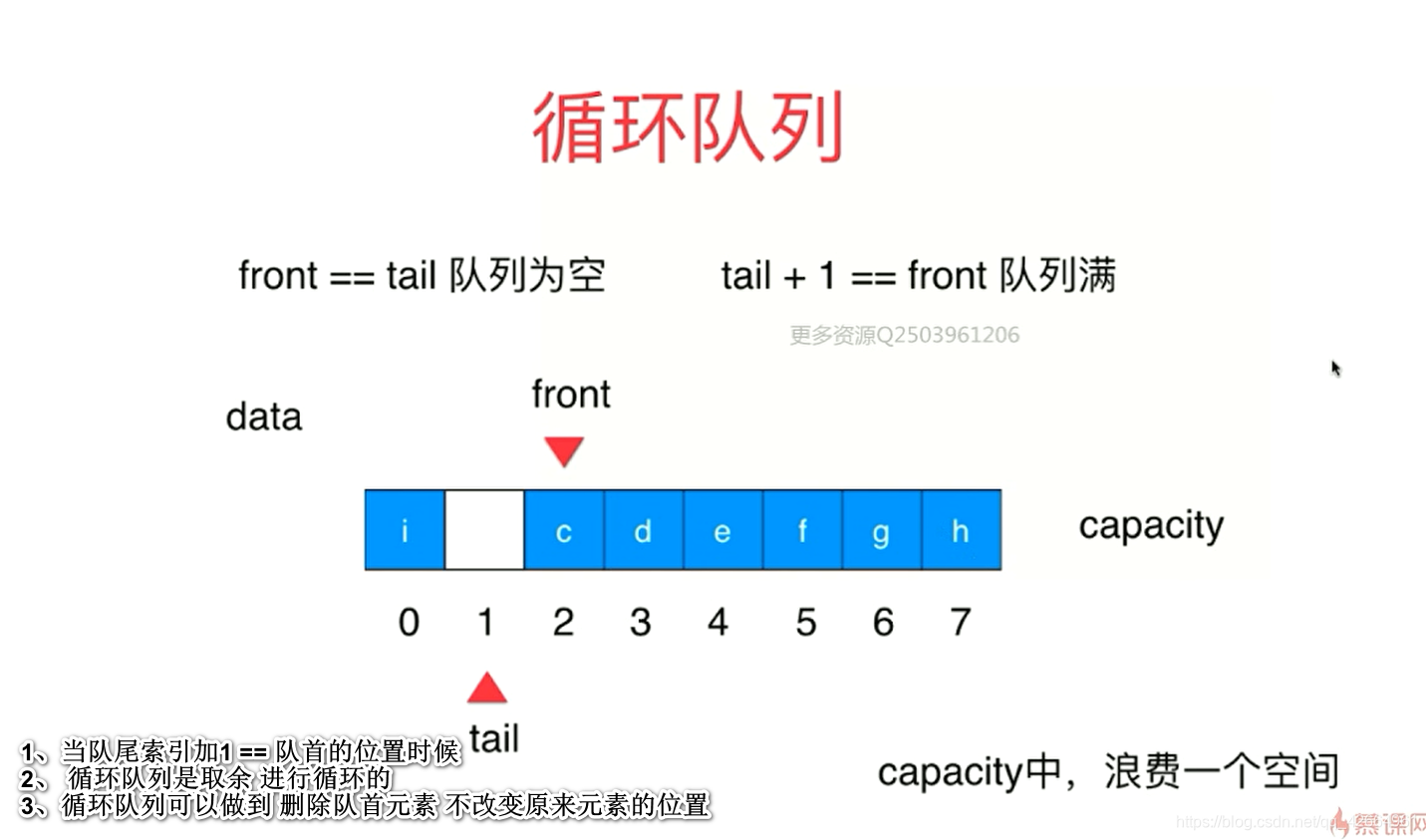1、当队尾索引+1 == 队首的位置时候
2、循环队列是取余 进行循环的
3、循环队列可以做到 删除队首元素 不改变原来元素的位置
开始队列为空的时候 front == tail

具体判断队列为满应该 (tail + 1)% c == front 队列满
取余之后就对其二者相等
循环的移动 循环队列的索引就像钟表循环


package queue;
/**
* 循环队列有意识的浪费一个空间
* <p>
* 这个类不在使用之前自定义的动态数组 自己从底层写起
* 支持泛型 实现接口 接口与动态数组是无关的
*
* @author lixw
* @date created in 9:17 2019/1/20
*/
public class LoopQueue<E> implements Queue<E> {
/**
* 需要有泛型 E[] 这个数组
*/
private E[] data;
/**
* 有两个int形式的变量
*/
private int front, tail;
/**
* 不用size 使用front tail也可以计算出 队列的大小来
*/
private int size;
/**
* 构造函数
* <p>
* 容量需要+1 ????
*/
public LoopQueue(int capacity) {
data = (E[]) new Object[capacity + 1];
front = 0;
tail = 0;
size = 0;
}
/**
* 无参构造
*/
public LoopQueue() {
this(10);
}
/**
* 获取循环数组的容量
*
* @return
*/
public int getCapacity() {
return data.length - 1;
}
@Override
public boolean isEmpty() {
return front == tail;
}
@Override
public int getSize() {
return size;
}
/**
* 入队
*
* @param e
*/
@Override
public void enqueue(E e) {
//1.首先是需要判断队列是否是满的
if ((tail + 1) % data.length == front) {
//2.扩容 循环队列有意识的浪费一个空间
resize(getCapacity() * 2);
}
data[tail] = e;
tail = (tail + 1) % data.length;
size++;
}
/**
* 出 队列
*
* @return
*/
@Override
public E dequeue() {
if (isEmpty()) {
throw new IllegalArgumentException("cannot dequeue from an empty queue");
}
E ret = data[front];
/**
* 将原来的front置为 null
*/
data[front] = null;
/**
* 队列只需要关注队列的 队首 和 队尾
* 所以讲队列的front所指向的位置向后移动一位
*/
front = (front + 1) % data.length;
size--;
/**
* 出队可以可以缩容量 减少为1/4的时候进行操作
*/
if (size == getCapacity() / 4 && getCapacity() / 2 != 0) {
resize(getCapacity() / 2);
}
return ret;
}
@Override
public E getFront() {
if (isEmpty()) {
throw new IllegalArgumentException("cannot get data from empty queue");
}
/**
* 直接返回队列的首部的位置
*/
return data[front];
}
/**
* 队列扩容
*
* @param newCapacity
*/
private void resize(int newCapacity) {
//3.循环数组需要浪费一个空间
E[] newData = (E[]) new Object[newCapacity + 1];
for (int i = 0; i < size; i++) {
/**
* 新的
*
* 33333333队列的首位置对应的
* 原来队列的 front 索引的位置
*
*
* i + front 在 i 不断增加的过程中会出现 溢出 需要取余
*/
newData[i] = data[(i + front) % data.length];
data = newData;
front = 0;
tail = size;
}
}
// 错误的写法
// @Override
// public String toString() {
// StringBuffer stringBuffer = new StringBuffer();
// stringBuffer.append("[");
// for (int i = 0; i < data.length; i++) {
// stringBuffer.append(data[front]);
// data[front] = null;
// //front 指针后移一位
// front = (front + 1) % data.length;
// //队列中需要遍历的位置数目减小一位
// size--;
// }
// stringBuffer.append("]");
// return stringBuffer.toString();
// }
@Override
public String toString() {
StringBuffer stringBuffer = new StringBuffer();
stringBuffer.append(String.format("Queue:size= %d, capacity:%d\n", size, getCapacity()));
stringBuffer.append("front[");
// for (int i = 0; i < size; i++) {
//循环列表与一般的不同
for (int i = front; i != tail; i = (i + 1) % data.length) {
stringBuffer.append(data[i]);
if (i != size - 1) {
stringBuffer.append(",");
}
}
stringBuffer.append("]tail");
return stringBuffer.toString();
}
public static void main(String[] args) {
LoopQueue<Integer> queue = new LoopQueue<>();
for (int i = 0; i < 10; i++) {
queue.enqueue(i);
System.out.println(queue);
if (i % 3 == 2) {
queue.dequeue();
System.out.println(queue);
}
}
System.out.println(10 / 4);
}
}
mian 函数的输出的结果:
Queue:size= 1, capacity:10
front[0]tail
Queue:size= 2, capacity:10
front[0,1]tail
Queue:size= 3, capacity:10
front[0,1,2]tail
Queue:size= 2, capacity:5
front[1,null]tail
Queue:size= 3, capacity:5
front[1,null,3]tail
Queue:size= 4, capacity:5
front[1,null,3,4]tail
Queue:size= 5, capacity:5
front[1,null,3,4,5]tail
Queue:size= 4, capacity:5
front[null,3,45,]tail
Queue:size= 5, capacity:5
front[null,3,4,56,]tail
Queue:size= 6, capacity:10
front[null,null,null,null,null,7]tail
Queue:size= 7, capacity:10
front[null,null,null,null,null,7,8]tail
Queue:size= 6, capacity:10
front[null,null,null,null,78,]tail
Queue:size= 7, capacity:10
front[null,null,null,null,7,89,]tail
2
Picked up JAVA_TOOL_OPTIONS: -Dfile.encoding=UTF-8
Process finished with exit code 0